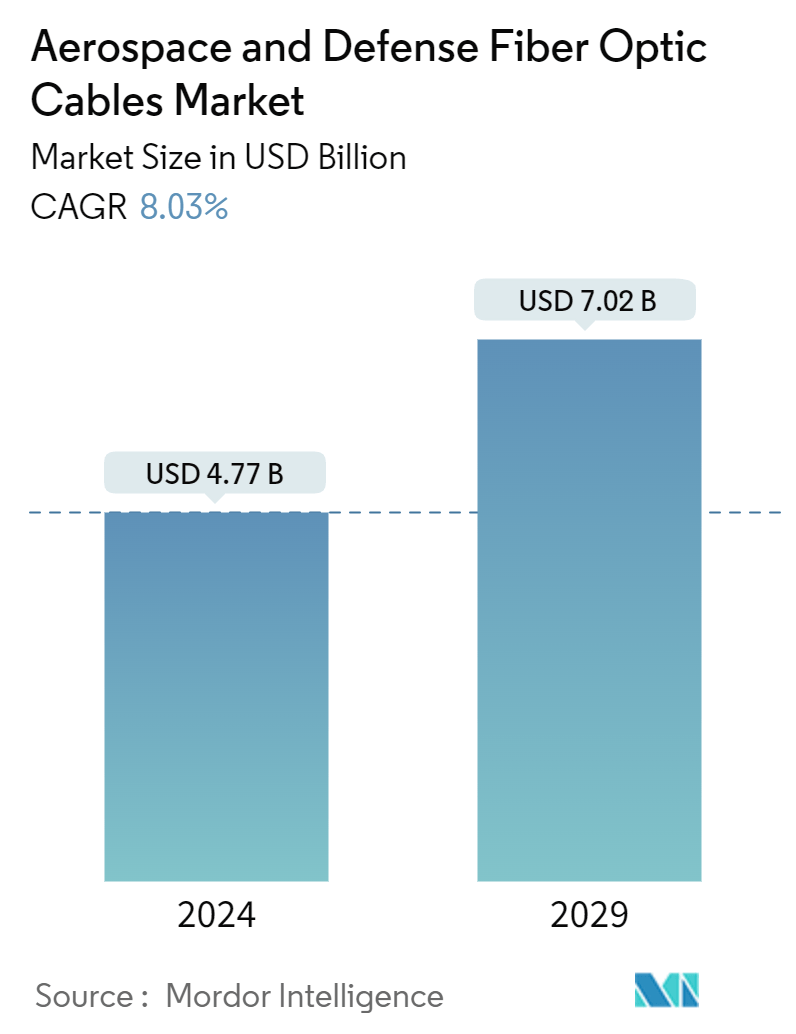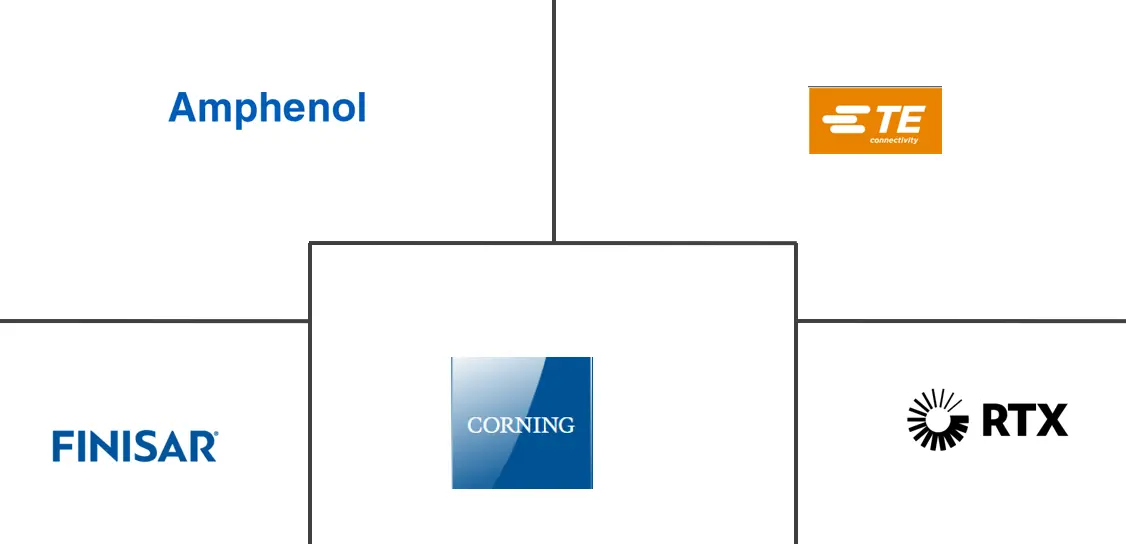Market Size of Aerospace And Defense Fiber Optic Cables Industry

| Study Period | 2019 - 2029 |
| Market Size (2024) | USD 4.77 Billion |
| Market Size (2029) | USD 7.02 Billion |
| CAGR (2024 - 2029) | 8.03 % |
| Fastest Growing Market | North America |
| Largest Market | Asia Pacific |
Major Players
*Disclaimer: Major Players sorted in no particular order |
Aerospace And Defense Fiber Optic Cables Market Analysis
The Aerospace And Defense Fiber Optic Cables Market size is estimated at USD 4.77 billion in 2024, and is expected to reach USD 7.02 billion by 2029, growing at a CAGR of 8.03% during the forecast period (2024-2029).
The market for aerospace and defense fiber optic cables is expected to witness significant growth. This can be attributed to the rising number of aircraft deliveries and an increasing demand for improved throughput and reliability. Authorities are now prioritizing adopting advanced solutions, replacing older cables, and further accelerating market expansion. With their innovative offerings, noteworthy players like Carlisle Interconnect Technologies are poised to drive this growth.
This market’s challenges loom in installing and maintaining fiber optic cables. These challenges include inflexible control models, risks to optical network systems, high costs, and susceptibility to damage, which hamper the growth of the market. Balancing the need for cost-effective fiber optics with maintaining high quality presents both an opportunity and a challenge for the market.
Aerospace And Defense Fiber Optic Cables Industry Segmentation
Fiber optic technology transmits data using highly flexible, transparent fibers of extruded glass or plastic. Fiber optic cables incorporate glass threads as thin as human hair, transmitting messages modulated into light waves. Although these cables are made of glass, they are highly durable and malleable.
The market for aerospace and defense fiber optic cables is segmented by application, type, and geography. By application, the market is segmented into communication systems, avionics, weapon systems, surveillance and reconnaissance, and electronic warfare. By type, the market is segmented into single-mode and multi-mode. The report also covers the market sizes and forecasts in major countries across different regions. The market size is provided for each segment in terms of value (USD).
| Application | |
| Communication Systems | |
| Avionics | |
| Weapon Systems | |
| Surveillance and Reconnaissance | |
| Electronic Warfare |
| Type | |
| Single-mode | |
| Multi-mode |
| Geography | |||||||
| |||||||
| |||||||
| |||||||
| |||||||
|
Aerospace And Defense Fiber Optic Cables Market Size Summary
The aerospace and defense fiber optic cables market is poised for substantial growth, driven by the increasing demand for advanced communication solutions in aircraft and defense systems. The shift from traditional copper cabling to fiber optic solutions is being propelled by the need for enhanced data throughput and reliability. This transition is particularly evident in the aviation sector, where airlines are upgrading to fiber optic systems to offer personalized in-flight services. In the military domain, fiber optic cables are being tailored for extreme environments, ensuring robust performance across various applications, including ground, air, sea, and space. Despite the promising growth trajectory, the market faces challenges related to the installation and maintenance of fiber optic systems, such as high costs and susceptibility to damage, which necessitate a balance between cost-effectiveness and quality.
The Asia-Pacific region is expected to lead the market, with China and India making significant investments in aerospace and defense initiatives, bolstered by a favorable regulatory environment and regional security challenges. Major industry players, including Amphenol, Carlisle Interconnect Technologies, and Corning Optical Communications, are strengthening their presence in this region, contributing to its market dominance. The market is characterized by fragmentation, with key players engaging in strategic partnerships and acquisitions to enhance their product offerings and maintain a competitive edge. Recent collaborations, such as RTX Corporation's partnership with the US Air Force, highlight the ongoing advancements in fiber optic technologies for defense applications. These developments underscore the dynamic nature of the market, with continuous innovation and strategic maneuvers shaping its future landscape.
Aerospace And Defense Fiber Optic Cables Market Size - Table of Contents
-
1. MARKET DYNAMICS
-
1.1 Market Overview
-
1.2 Market Drivers
-
1.3 Market Restraints
-
1.4 Porter's Five Forces Analysis
-
1.4.1 Bargaining Power of Buyers/Consumers
-
1.4.2 Bargaining Power of Suppliers
-
1.4.3 Threat of New Entrants
-
1.4.4 Threat of Substitute Products
-
1.4.5 Intensity of Competitive Rivalry
-
-
-
2. MARKET SEGMENTATION
-
2.1 Application
-
2.1.1 Communication Systems
-
2.1.2 Avionics
-
2.1.3 Weapon Systems
-
2.1.4 Surveillance and Reconnaissance
-
2.1.5 Electronic Warfare
-
-
2.2 Type
-
2.2.1 Single-mode
-
2.2.2 Multi-mode
-
-
2.3 Geography
-
2.3.1 North America
-
2.3.1.1 US
-
2.3.1.2 Canada
-
-
2.3.2 Europe
-
2.3.2.1 United Kingdom
-
2.3.2.2 France
-
2.3.2.3 Germany
-
2.3.2.4 Russia
-
2.3.2.5 Rest of Europe
-
-
2.3.3 Asia-Pacific
-
2.3.3.1 China
-
2.3.3.2 India
-
2.3.3.3 Japan
-
2.3.3.4 South Korea
-
2.3.3.5 Rest of Asia-Pacific
-
-
2.3.4 Latin America
-
2.3.4.1 Brazil
-
2.3.4.2 Rest of Latin America
-
-
2.3.5 Middle East and Africa
-
2.3.5.1 Saudi Arabia
-
2.3.5.2 United Arab Emirates
-
2.3.5.3 Rest of Middle East and Africa
-
-
-
Aerospace And Defense Fiber Optic Cables Market Size FAQs
How big is the Aerospace And Defense Fiber Optic Cables Market?
The Aerospace And Defense Fiber Optic Cables Market size is expected to reach USD 4.77 billion in 2024 and grow at a CAGR of 8.03% to reach USD 7.02 billion by 2029.
What is the current Aerospace And Defense Fiber Optic Cables Market size?
In 2024, the Aerospace And Defense Fiber Optic Cables Market size is expected to reach USD 4.77 billion.

